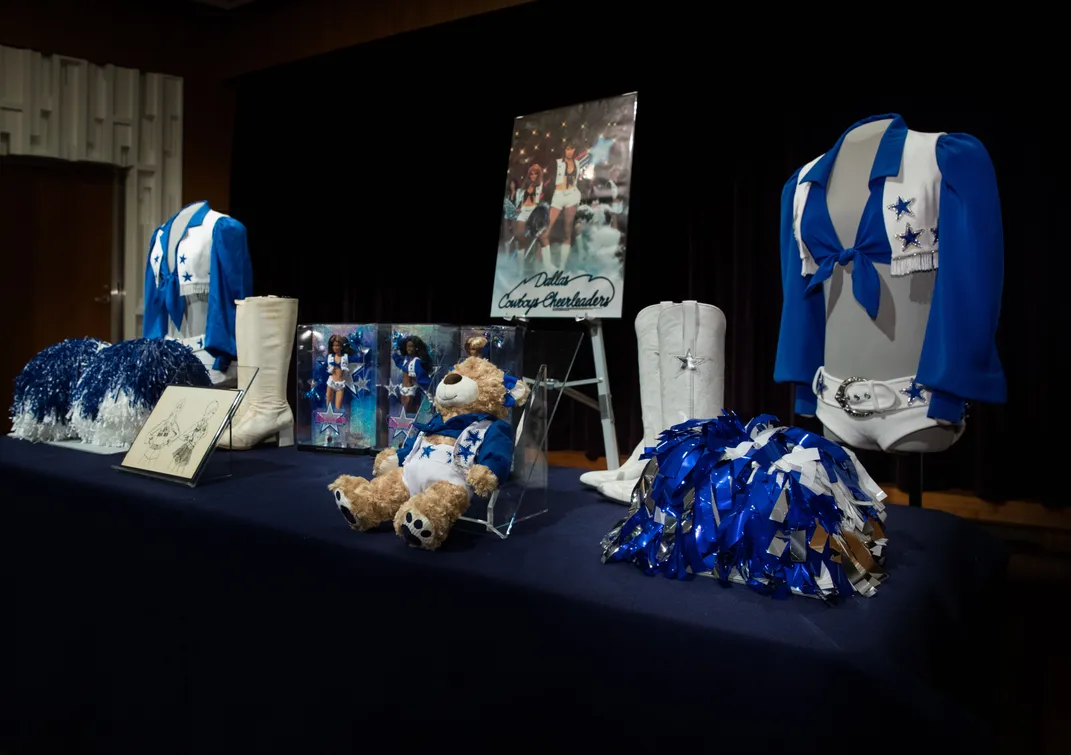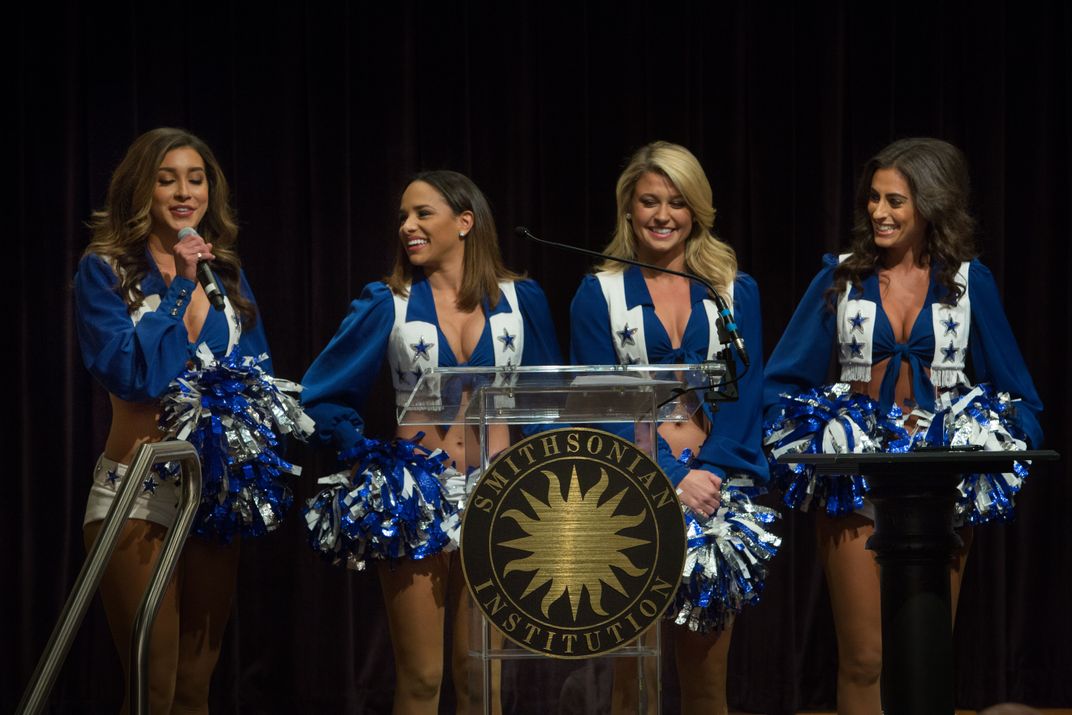A Classic American Cheerleading Troupe Tumbles to Smithsonian Immortality
“America’s Sweethearts” are as dedicated to social service as they are to the Dallas Cowboys
:focal(3637x1474:3638x1475)/https://tf-cmsv2-smithsonianmag-media.s3.amazonaws.com/filer/4c/74/4c747d23-d15d-4113-8b04-8b5d4ea2419d/cheer4.jpg)
As she gamely signed her name on the museum donation paperwork before a live audience earlier this week, Dallas Cowboys executive vice president Charlotte Jones Anderson addressed the four young cheerleader captains seated towards the front of the room with a proud smile. “You’re making history, girls!”
The sizable donation, the latest to join the sports collection at the National Museum of American History, included Dallas Cowboys Cheerleaders regalia—instantly recognizable to even the most occasional of football viewers—and an original 1977 DCC poster, one of a set that broke fresh ground in NFL marketing at the time of its release. Thrown in as bonuses were an authentic Cowboys Abbey Bear—a little blonde-furred teddy awarded weekly to exemplary DCC dancers—and a trio of Cowboys cheerleader Barbie dolls.
One of the two blue and white uniforms (complete with pom-poms and boots) joining the Smithsonian’s collection dates to the 1980s, when the outfits worn by “America’s Sweethearts,” as the squad is affectionately known, were essentially identical to the initial sketches of Paula Van Wagoner. Van Wagoner, a Dallas-based fashionista, had been commissioned by Cowboys GM Tex Schramm to come up with a flexible, Western-inspired, sexy but tasteful look for the cheer squad back in 1972. (She was in attendance for the donation festivities.)
The other donated uniform, from the 2011 season, is remarkably similar—the bold overall look of the knotted crop top and belted hot pants remains to this day true to its roots. Still, current DCC director Kelli Finglass says, “we’ve made some little tweaks here and there.” In keeping with modern trends, the 2011 outfit is more revealing than its ancestor, and its short shorts boast an eye-catching Western-style belt that Dallas sculptor Brad Oldham (also on hand for the ceremony) came up with in 2006.

In his opening remarks, the museum’s director John Gray praised not merely the artifacts themselves but the women they represented: “amazing athletes and teammates,” he said, “who in addition to pursuing full time careers”—or actively working toward university degrees—“train day in and day out, and perform at the same extraordinary level as the others on the field.”
This admiration was echoed and amplified by Kelli Finglass, who called attention to the demanding schedules faced by the cheer team. The Cowboys Cheerleaders convene four to five times per week for four-hour rehearsal blocks, all while holding down jobs or taking classes.
“We’re very proud that these are high-achieving women—overachievers,” she says. She also noted the geographic diversity of the modern roster, whose members hail from 19 separate states as well as two foreign nations (Australia and Japan) and have ties to 34 distinct colleges across the U.S.
In light of these performers’ rigorous standards and work ethic, one can understand why the cheerleading industry in both the National Football League and the National Basketball Association has been widely criticized for its low pay and long hours. A number of squads have successfully sued for better wages, though their pay remains commensurate with that of everyday baristas and waitresses despite their visibility and outsized contribution to team spirit. Dallas’s cheerleaders are among the best-paid in the business, but many outside commentators think even they deserve much more than they’re currently earning, and that across-the-board pay reform in professional sports is long overdue.
Historically, cheerleading has been a passion project for women looking to both hone their dance skills and serve their communities and country. As Finglass explained, the DCC have a particularly rich legacy of service to the U.S. military. “This uniform has traveled on 83 USO tours spanning 42 countries,” she said, a track record that earned the cheerleading company the Spirit of Hope Award (named for comedian Bob Hope) in its inaugural year, 1997.
Cheerleaders not only “provide a connection between the fans and the team,” Smithsonian sports curator Jane Rogers contends, but—since their debut in Depression-era America under the guidance of cheer pioneer Gussie Nell Davis—“have helped to create our national identity, from community and school fields to collegiate and professional arenas.”

Singling out the DCC, Rogers says that the iconic cheer squad “raised the bar for NFL cheerleaders in the 1970s, using athleticism and a strong sense of self to set the standard for what an organization of empowered women could accomplish.”
Four current members of the DCC—the four group leaders who helm rehearsals and live performances—were present at the event in full uniform, and all gave brief testimonials at its conclusion. “The experiences that we get to go through make us the best of friends,” said self-professed “hometown Dallas girl” Lacey, “and the sisterhood that you take with it is like nothing else.”
After a flurry of photography, Charlotte Jones Anderson, visibly very excited, spoke to this reporter on the impact of the moment. “This is an incredible day,” she said. “I never thought when I first got involved with the Cowboys”—29 years ago this past Sunday—“that we’d be standing here at the Smithsonian. This is an amazing opportunity.”
Anderson has no doubt that the Cowboys Cheerleaders have earned their place in the annals of the American History Museum. “We’re a part of American culture,” she said, adding that the DCC are models of the sort of perseverance and resolve on which the nation was founded. “It’s about sports, it’s about entertainment, it’s about tradition, and it’s about inspiration all together.”
/https://tf-cmsv2-smithsonianmag-media.s3.amazonaws.com/accounts/headshot/DSC_02399_copy.jpg)
/https://tf-cmsv2-smithsonianmag-media.s3.amazonaws.com/accounts/headshot/DSC_02399_copy.jpg)